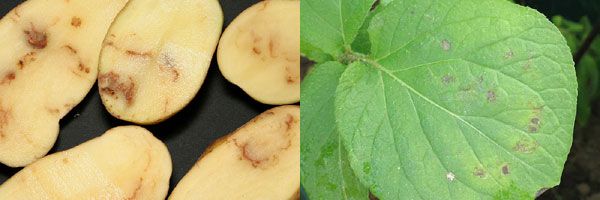
Tobacco rattle virus
(TRV)
- Causal agent and transmission
Tobacco rattle virus (TRV) is transmitted by nematodes of the genera Trichodorus and Paratrichodorus (Trichodoridae), which are polyphagous ectoparasites moving freely in the rhizosphere. There is some evidence of specificity between virus strain and vector species.
Adults and juveniles can transmit the virus when feeding on root cells and the virus can be retained for many months by non-feeding nematodes. There is no evidence for the multiplication of the virus in the vector and it is probably not transmitted through nematode eggs.
Sandy and loamy light soils and high soil content favour the vector activity but TRV and its vector have been found in very diverse types of soil.
The nematodes can be readily detected by soil analysis although they may be patchily distributed within a field. The virus in its infectious stage can remain in the nematode for several months and in an infested plot for several years, or even several decades, in host plants.
TRV is also disseminated by (botanical) seeds of numerous weed species, grasses in particular. The roots of these plants serve as useful virus reservoirs for the nematodes, which transmit the virus to the potato tubers.
However, necrosis-carrying tubers are generally regarded as poor virus sources for non- viruliferous nematodes.
- Significance
The economic significance of TRV is mainly related to the presence of necrotic symptoms on tubers which may lower the value and even lead to the downgrading or rejection of the affected potato lots.
TRV is a soil-borne disease and its transmission by seed tubers is not considered as important. Seed tubers with symptoms usually produce healthy plants (self-elimination), and, very rarely, infected plants producing symptom-free daughter tubers.
TRV may, however, be transmitted by seed tubers (from one generation to the next) in some cultivars in which the infection is symptom-free.





